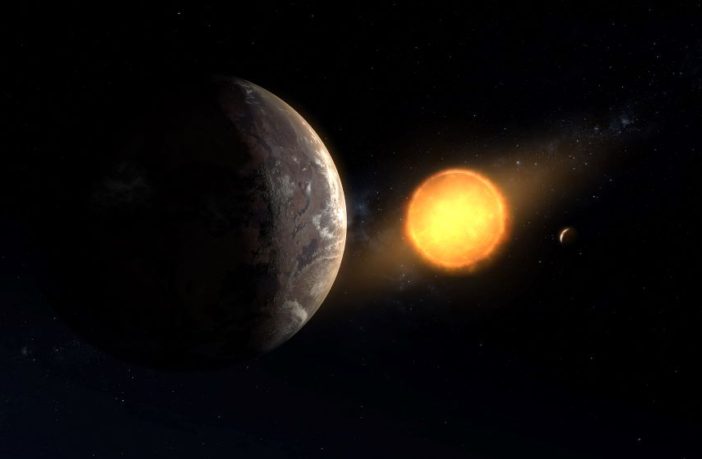A team of scientists from around the world have discovered an Earth-size exoplanet orbiting in its star’s habitable zone, the area around a star where a rocky planet could support liquid water.
Scientists from The Open University, NASA, University of Texas, SETI Institute and the Harvard-Smithsonian Center for Astrophysics discovered a new planet, called Kepler-1649c, when looking through old observations from NASA’s Kepler space telescope, which the agency retired in 2018.
While previous searches with a computer algorithm misidentified it, researchers reviewing Kepler data took a second look at the signature and recognized it as a planet. Out of all the exoplanets found by Kepler, this distant world – located 300 light-years from Earth – is most similar to Earth in size and estimated temperature.
This newly revealed world is only 1.06 times larger than our own planet. Also, the amount of starlight it receives from its host star is 75% of the amount of light Earth receives from our Sun – meaning the exoplanet’s temperature may be similar to our planet’s, as well. But unlike Earth, it orbits a red dwarf star. Though none have been observed in this system, this type of star is known for stellar flare-ups that may make a planet’s environment challenging for any potential life.
Thomas Zurbuchen, Associate Administrator of NASA’s Science Mission Directorate in Washington, comments:
“This intriguing, distant world gives us even greater hope that a second Earth lies among the stars, waiting to be found. The data gathered by missions like Kepler and our Transiting Exoplanet Survey Satellite (TESS) will continue to yield amazing discoveries as the science community refines its abilities to look for promising planets year after year.”
Searching for habitable worlds
There is still much that is unknown about Kepler-1649c, including its atmosphere, which could affect the planet’s temperature. Current calculations of the planet’s size have significant margins of error, as do all values in astronomy when studying objects so far away. But based on what is known, Kepler-1649c is especially intriguing for scientists looking for worlds with potentially habitable conditions.
There are other exoplanets estimated to be closer to Earth in size, such as TRAPPIST-1f and, by some calculations, Teegarden c. Others may be closer to Earth in temperature, such as TRAPPIST-1d and TOI 700d. But there is no other exoplanet that is considered to be closer to Earth in both of these values that also lies in the habitable zone of its system.
Andrew Vanderburg, a researcher at the University of Texas at Austin, said:
“Out of all the mislabeled planets we’ve recovered, this one’s particularly exciting – not just because it’s in the habitable zone and Earth-size, but because of how it might interact with this neighboring planet. If we hadn’t looked over the algorithm’s work by hand, we would have missed it.”
Kepler-1649c orbits its small red dwarf star so closely that a year on Kepler-1649c is equivalent to only 19.5 Earth days. The system has another rocky planet of about the same size, but it orbits the star at about half the distance of Kepler-1649c, similar to how Venus orbits our Sun at about half the distance that Earth does. Red dwarf stars are among the most common in the galaxy, meaning planets like this one could be more common than we previously thought.
Looking for false positives
Previously, scientists on the Kepler mission developed an algorithm called Robovetter to help sort through the massive amounts of data produced by the Kepler spacecraft, managed by NASA’s Ames Research Center in California’s Silicon Valley. Kepler searched for planets using the transit method, staring at stars, looking for dips in brightness as planets passed in front of their host stars.
Most of the time, those dips come from phenomena other than planets – ranging from natural changes in a star’s brightness to other cosmic objects passing by – making it look like a planet is there when it’s not. Robovetter’s job was to distinguish the 12% of dips that were real planets from the rest. Those signatures Robovetter determined to be from other sources were labelled “false positives,” the term for a test result mistakenly classified as positive.
With an enormous number of tricky signals, astronomers knew the algorithm would make mistakes and would need to be double-checked – a perfect job for the Kepler False Positive Working Group. That team reviewed Robovetter’s work, going through each false positive to ensure they are truly errors and not exoplanets, ensuring fewer potential discoveries are overlooked. As it turns out, Robovetter had mislabelled Kepler-1649c.
Former OU student’s starring role in planet’s discovery
Pamela Rowden, a former PhD student at The Open University, vetted Kepler-1649c and brought it to the working group’s attention. Speaking on the discovery, Pamela said:
“Kepler-1649 c is a fascinating planet, and I am very proud to have been part of the team which identified it. Who knows how many similar planets may be out there, just waiting to be discovered? This is an exciting time to be an astrophysicist!”
Even as scientists work to further automate analysis processes to get the most science as possible out of any given data set, this discovery shows the value of double-checking automated work. Even six years after Kepler stopped collecting data from the original Kepler field – a patch of sky it stared at from 2009 to 2013, before going on to study many more regions – this rigorous analysis uncovered one of the most unique Earth analogues discovered yet.
For more on the discovery of Kepler-1649 read the paper published today in The Astrophysical Journal Letters.



